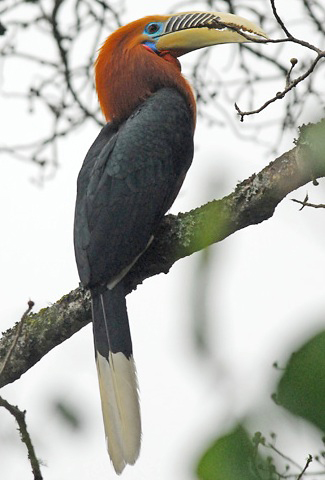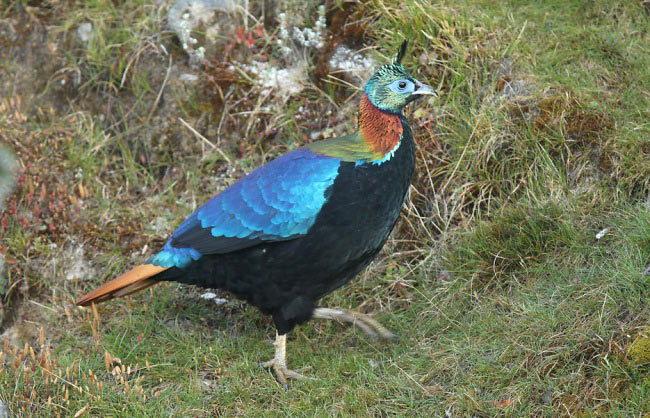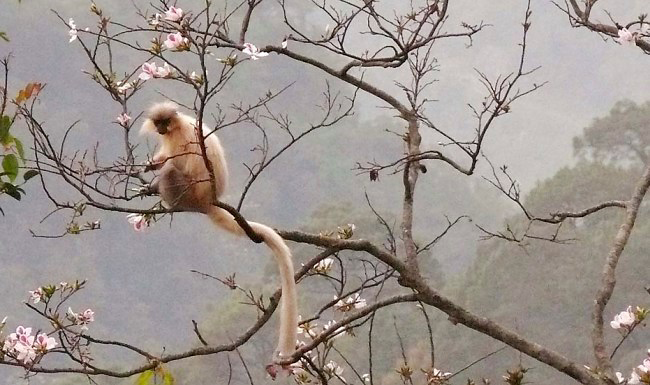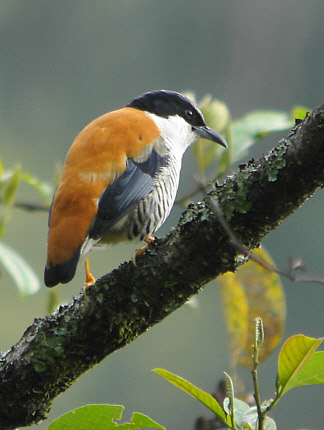

Rufous-necked Hornbill along the Lingmethang Road in Bhutan by Paul Noakes.
- Some of the best birding in the Himalayas with over 640 species recorded in a country half the size of Scotland
- Thanks to the beautiful habitats and scenery, completed by the likes of Himalayan Monal, Satyr Tragopan, Blood Pheasant, Ward’s Trogon and Rufous-necked Hornbill, Beautiful Nuthatch, and scimitar, shrike and wren babblers
- Plus a chance of White-bellied Heron, Pallas’s Fish-eagle, Snow Pigeon and Fire-tailed Myzornis
- As well as more widespread spectacular species such as Ibisbill, Crested Kingfisher, Long-tailed Broadbill, White-crested Laughingthrush, Himalayan Cutia, Golden-breasted Fulvetta, Sultan Tit and Fire-tailed Sunbird
- And mammals including Capped, Golden and Nepal Grey Langurs, Yellow-throated Marten and giant flying squirrels
- All in a happy, sparsely populated country where Gross National Happiness is more important than Gross Domestic Product
- Hence vast tracts of pristine forests full of birds remain on some of the steepest mountains

A fantastic Himalayan Monal wandering around a monastery grounds in Bhutan in front of Brian Field.
- The mainly Buddhist people of Bhutan are happy to live simple lives. They are not interested in hunting and logging and the government has vowed to keep at least 60% of the country forested, in the belief that a healthy, natural environment is essential for material and spiritual happiness. If only the rest of the world would follow their example.
- To help preserve the pristine habitats the number of visitors is carefully controlled, the government charges a high price for the privilege of entering and all visitors must be on organized tours. These are some of the reasons why tours to Bhutan are so expensive, but the high price is worth it, and should ensure that future generations will be able to enjoy Bhutan too, in the company of few fellow tourists.
- Visitors with heart or respiratory concerns should contact their doctor prior to departure because touring Bhutan involves ascending to elevations above 10,000 and as high as 13,000 feet.
Best Birds and other wildlife in Bhutan
Birds
Near-endemics
Bhutan and India 1 Bhutan (Streaked) Laughingthrush.
Bhutan, India and Myanmar 1 Spot-breasted Scimitar-babbler.
Bhutan, India, Bangladesh and Myanmar 1 White-bellied Heron.
Bhutan, India, Nepal and China 5 Coral-billed Scimitar-babbler, Blackish-breasted Babbler (Wedge-billed Wren-babbler), Hoary-throated Barwing, Rufous-necked Snowfinch and Plain-backed (Blanford’s) Snowfinch.
Bhutan, India, Nepal, China and Central Asia 1 Ground Tit (Hume’s Ground Jay).
Bhutan, India and China 4 Chestnut-breasted Partridge, Tibetan Eared-pheasant, Black-necked Crane (up to 350 spend the northern winter in the Phobjikha Valley, mostly Nov-Mar) and White-breasted Parrotbill.
Bhutan, India, Nepal, Bangladesh, Myanmar and China 1 Firethroat.
Other specialities
Himalayan Monal, Satyr Tragopan, Blood Pheasant, Ibisbill, Ward’s Trogon, Crested Kingfisher, Rufous-necked Hornbill, Yellow-rumped Honeyguide, Yellow-vented Warbler,
Beautiful Nuthatch, Blue-fronted Robin, Indian Blue Robin, Spotted Elachura (formerly Wren Babbler, now in a family of its own), Bar-winged and Long-billed
Wren-babblers, Yellow-throated Fulvetta, White-naped Yuhina, Fire-tailed Myzornis, Crimson-browed and Gold-naped Finches, and Red-headed Bullfinch.
Also a chance of Hill and Rufous-throated Partridges, Pallas’s Fish-eagle, Black-tailed Crake, Solitary Snipe, Snow Pigeon, Dark-rumped Swift, Blyth’s Kingfisher, Blue-naped and Western Hooded Pittas, Gould's Shortwing and Wallcreeper.
Others
Indian Peafowl, Kalij Pheasant, Himalayan Griffon, Black and Rufous-bellied Eagles, River Lapwing, Green-billed Malkoha, Asian Emerald and Violet Cuckoos,
White-throated
Needletail, Red-headed Trogon, Blue-bearded and Chestnut-headed Bee-eaters, Great and Oriental Pied Hornbills, barbets, woodpeckers including Great Slaty,
Long-tailed Broadbill,
minivets,
Grey-backed Shrike, Maroon and Slender-billed Orioles, drongos, Yellow-bellied Fairy-fantail, Common Green and Yellow-billed Blue Magpies, Southern
Nutcracker, Sultan Tit, bulbuls, Mountain Tailorbird, Chestnut-headed, Grey-bellied and Slaty-bellied Tesias, warblers, parrotbills, flycatchers including
Sapphire, niltavas, Himalayan and Lesser Shortwings, Golden and White-browed Bush-robins, White-rumped Shama, redstarts, White-tailed Blue Robin,
forktails, rock-thrushes, laughingthrushes including Spotted and White-crested, Red-faced Liocichla, scimitar-babblers including Slender-billed,
shrike-babblers, wren-babblers, Himalayan Cutia, Red-billed Leiothrix, Silver-eared Mesia, Red-tailed Minla, barwings, Rufous and Long-tailed Sibias,
Golden-breasted Fulvetta, yuhinas, Asian Fairy-bluebird, Golden-fronted and Orange-bellied Leafbirds, Streaked Spiderhunter, Gould's and Fire-tailed
Sunbirds, Rufous-breasted Accentor, Scarlet Finch, rosefinches, and Collared and White-winged Grosbeaks. Also a chance of Lammergeier.
Mammals
Capped, Golden and Nepal Grey Langurs, Assamese Macaque, Yellow-throated Marten, Black Giant, Hodgson's Flying and Red Giant Flying Squirrels,
Moupin Pika and Indian Muntjac. Also a chance of Common Goral, and on the three-week-long Tashitang Trek, an outside chance of Snow Leopard, Red Panda
and Takin.

Golden Langur by Jon Hornbuckle.
Plants
Bhutan has an amazing flora including many species of buddleias, daphnes, magnolias and rhododendrons.
Other Natural Wonders in Bhutan
Gangkhar Puensum
The beautiful Himalayan scenery in Bhutan includes many snow-capped mountains. The highest is Gangkhar Puensum, which at 7541 m (24,740 ft) is also
the highest unclimbed mountain in the world.
Best Sites for Birds and other wildlife in Bhutan
- Paro Valley Ibisbill. Also a chance of Black-tailed Crake.
- Cheli La (3780 m/12,401 ft) Himalayan Monal, Blood Pheasant, Gould’s Sunbird, and Collared and White-winged Grosbeaks. Also a chance of Solitary Snipe.
- Thimpu to Dochu La to Punakha Satyr Tragopan and Himalayan Cutia. Also a chance of Fire-tailed Myzornis.
- Mo Chu Valley Red-headed Trogon, Crested Kingfisher and Slaty-backed Forktail. Also a chance of White-bellied Heron, Pallas’s Fish-eagle and Ibisbill.
- Punakha to Pele La (3300m/10,827 ft) to Trongsa Ward’s Trogon, Yellow-rumped Honeyguide, Spotted Forktail and Fire-tailed Sunbird. Also a chance of Lammergeier.
- Zhemgang Valley Rufous-necked Hornbill, Long-tailed Broadbill, Beautiful Nuthatch, Golden Langur and Hodgson's Flying Squirrel.
- Tingtibi Great Hornbill, woodpeckers, Sultan Tit and laughingthrushes.
- Gelephu Indian Peafowl, Chestnut-headed Bee-eater and Great Slaty Woodpecker.
- Trongsa to Yutong La (3400 m/11,155 ft) to Jakar A chance of Himalayan Monal.
- Thrumsing La (3700m/12,139 ft) Blood Pheasant and Spotted Laughingthrush. Also a chance of Snow Pigeon.
- Chhume Valley A chance of Himalayan Monal coming to grain put out by monks at the Tharpaling Monastery, especially at dawn and dusk.
- Lingmethang Road (including Yongko La) Satyr Tragopan, Asian Emerald Cuckoo, Red-headed and Ward’s Trogons, Blue-bearded Bee-eater, Rufous-necked Hornbill, Chestnut-headed Tesia, Black-throated Parrotbill, Blue-fronted Robin, laughingthrushes including White-crested, Fire-tailed Myzornis, Himalayan Cutia, scimitar-babblers, shrike-babblers, Bar-winged Wren-babbler, Golden-breasted and Yellow-throated Fulvettas, Rusty-fronted Barwing, White-naped Yuhina and Hodgson's Flying Squirrel. Also a chance of Chestnut-breasted and Rufous-throated Partridges, Blue-naped Pitta, Black-headed Shrike-babbler and Gold-naped Finch, and an outside chance of Gould’s Shortwing.
- Kori La Grey-bellied Tesia, Spotted Forktail and Hoary-throated Barwing.
- Deothang White-throated Needletail, Rufous-necked Hornbill, Common Green Magpie, Beautiful Nuthatch, Blue-winged Laughingthrush, Red-faced Liocichla and Silver-eared Mesia.
- Samdrup Jongkhar Green-billed Malkoha, Violet Cuckoo, Great and Oriental Pied Hornbills, Long-tailed Broadbill, Sultan Tit, Asian Fairy-bluebird and Black-backed Forktail. Also a chance of Dark-rumped Swift and Blyth’s Kingfisher.

Himalayan Cutia by Ian Fulton.
Best Times for Birds and other wildlife in Bhutan
The best time to be in Bhutan for birds is normally late March to early May when many resident species nest, species which breed at high-altitude are still wintering at lower altitude, summer visitors from the south are arriving and migrants are passing through on their way north. Late March to early May is also usually peak time to see many rhododendrons and magnolias in flower.
Recommended Bird Books etc. for Bhutan
Birds of Bhutan and the Eastern Himalayas by R Grimmett et al. Helm, 2019 (Third Edition).
Birds of the Indian Subcontinent by R Grimmett, and C and T Inskipp. Helm, 2012.
A Field Guide to the Birds of the Indian Subcontinent by K Kazmierczak. Helm, 2008.
Pocket Guide to the Birds of the Indian Subcontinent by R Grimmett, and C and T Inskipp. Helm, 1999.
Field Guide to the Birds of Nepal by R Grimmett, and C and T Inskipp. Helm, 2000 (Second Edition due September 2016).
Birds of South Asia: The Ripley Guide Volumes 1 and 2 by P C Rasmussen and J C Anderton. Lynx Edicions and Smithsonian Institution, 2012.
Indian Mammals: A Field Guide by V Menon. Hachette, 2014.
Field Guide to the Mammals of the Indian Subcontinent by K K Gurung and R Singh. Helm, 1998.
Apps etc.
eGuide to Birds of the Indian Subcontinent.
Where to watch birds in Asia by N Wheatley. Helm, 1996.
Don’t know which country/countries/regions to visit in Asia? Then it may be worth considering taking a look at this book, written by this website’s author. It is many years old of course but it still provides a starting point, an overview and a guiding light to the best birds and the best places to look for them in the region, and could save hours of searching for similar information on the internet. However, it is important to check more up-to-date sources for sites which have been opened up, sites and species which have been discovered, lodges that have been built etc. since the book was published.
Birding and Wildlife Trip Reports for Bhutan
Many trip reports, some for Bhutan, are posted on the websites listed here. On some of these websites some reports are independent and some are posted by tour companies who organize tours to Bhutan. These tour companies and others also post their own reports on their websites, which are listed under 'Some Organized Tours to Bhutan' below.
- The best website for trip reports is CloudBirders
- but these are also worth a look
- Birdtours
- Fatbirder
- Jon Hornbuckle
- Mammal Watching
Local bird and wildlife guides in Bhutan
The costs of organized tours partly reflect the quality of the tour leaders. Some leaders are certainly better than others and many companies claim their leaders are the best but even the best rely at least to some extent on the exceptional skills of the local guides they employ. If you are travelling independently, employing such local guides will greatly increase your chances of seeing the wildlife you wish to see.
Accommodation for birders in Bhutan
Some Organized Tours for birds and other wildlife to Bhutan
There are many tour companies who organize tours to see mammals, birds, other wildlife and other natural wonders. The cost of these tours vary considerably according to such variables as the airlines used, the number of days the tours last, the number of sites visited, the number of people in the group (an important consideration if you wish to see such wildlife as rainforest mammals and birds), the number of tour leaders, the standard of accommodation and transport, and the percentage profit the company hopes to make. Generally, where the number of days tours last and the number of sites visited are similar, the cheapest tours are those that use the cheapest airlines, accommodation and local transport, that have the largest groups with the least number of leaders, and that make the least amount of profit. The most expensive tours tend to be those which are exceptionally long, use the most expensive accommodation (ridiculously lavish in some cases, even for single nights) and which make the most profit. Some tour costs partly reflect the quality of the tour leaders. Some leaders are certainly better than others and many companies claim their leaders are the best but even the best rely at least to some extent on the exceptional skills of the local guides they employ.
While tour companies organize tours with set itineraries many also organize custom tours for individuals and private groups who instead of taking a tour with a set itinerary want to follow their own itinerary to suit their own personal tastes, whether it be mammals, birds, other wildlife, other natural wonders or even man-made attractions, or a mixture of them all. Many organized tours with set itineraries are also fast-paced and target as many species as possible, whether they are mammals, birds or other wildlife or everything, which usually leaves little time to enjoy the best sites and individual species, but on a custom tour those taking part can specify the pace and the sites and species they wish to concentrate on. Custom tours also suit people who like to travel with people they already know, rather than with a group of strangers, and people with partners with different interests. Individuals and small groups will almost certainly have to pay more than the price of an organized tour with a set itinerary but a large group of friends may be able to travel for less than the price quoted for a set tour.
Tour companies who run organized tours or can arrange custom tours to Bhutan include the following.
